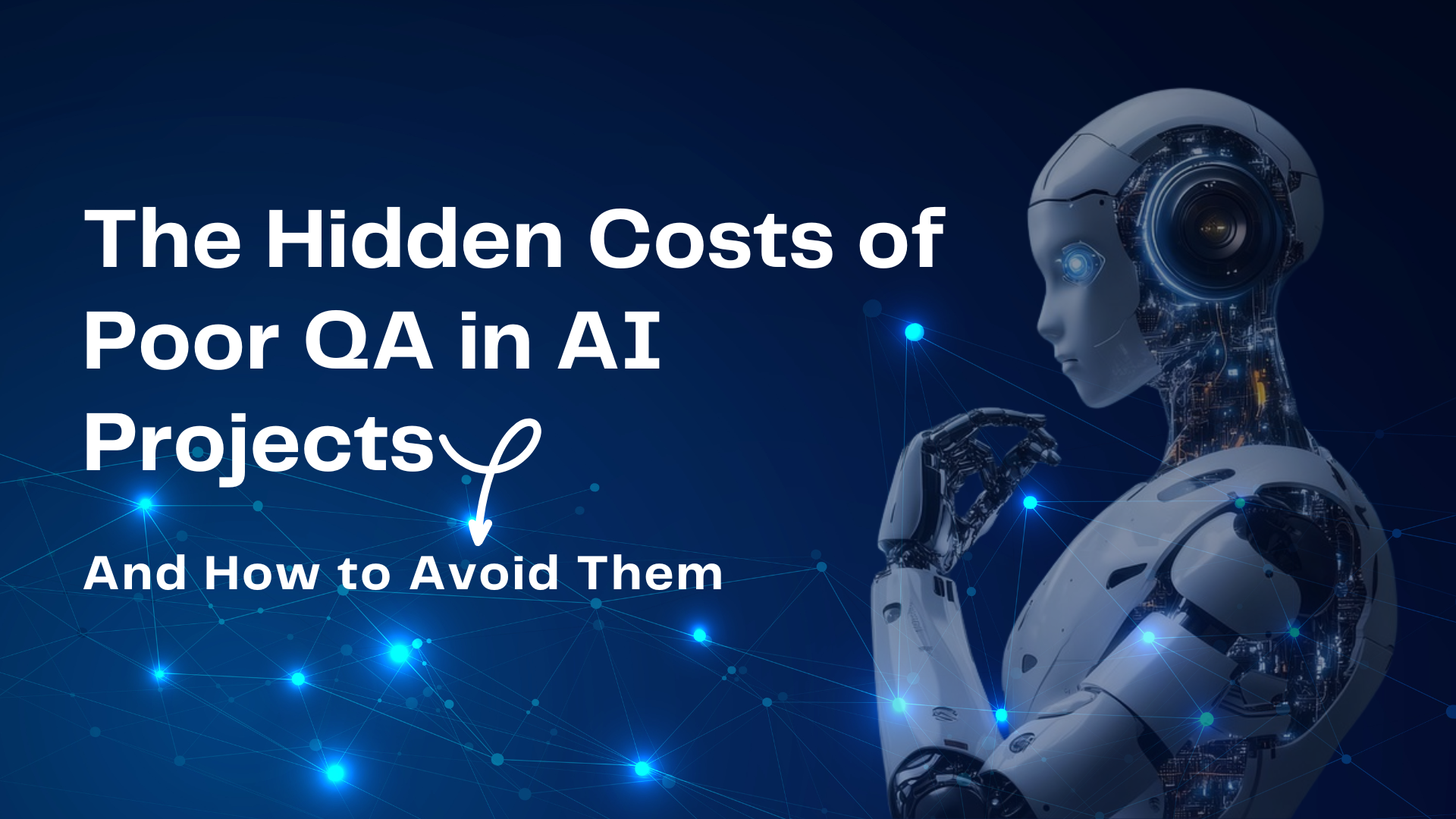Introduction
AI is everywhere—powering recommendation engines, fraud detection, customer support, and even medical diagnostics. But as powerful as these systems are, they can just as easily backfire. When quality assurance (QA) is neglected, the consequences are far-reaching: wasted budgets, damaged reputations, and compliance headaches. In fact, according to the Consortium for Information & Software Quality (CISQ), the U.S. alone lost at least $2.41 trillion to poor software quality in 2022. AI projects, with their complexity and reliance on massive datasets, amplify these risks.
So, what exactly happens when QA takes a back seat in AI initiatives—and how can businesses avoid these hidden costs?
The Financial Fallout of Poor QA
Direct Costs: Technical Debt and Rework
Technical debt piles up quickly in AI projects. CISQ estimates that accumulated technical debt in U.S. software reached about $1.52 trillion in 2022. Developers spend nearly 33% of their time—around 13.5 hours a week—managing this debt instead of building new features. In AI, where models constantly evolve, this wasted time directly translates to lost innovation.
Indirect Costs: Delays and Abandoned Projects
Inadequate QA doesn’t just increase rework—it can derail entire timelines. NIST research found that poor testing cost the U.S. economy about $59.5 billion annually. That’s not just money wasted on fixes; it’s lost market opportunities. Projects delayed by faulty AI models often get abandoned before they ever deliver ROI.
Breach Costs: The Price of Neglected QA
Security testing is a huge part of AI QA. The IBM Cost of a Data Breach Report 2025 revealed that the average global breach now costs $4.4 million. What’s more alarming is that 97% of organizations with AI-related security incidents lacked proper AI access controls. Without thorough QA and testing for vulnerabilities, AI can become a gateway for cyberattacks.
Reputational Damage
Faulty Models Undermine Trust
When an AI tool makes the wrong call, people notice. A chatbot giving offensive responses. A fraud detection system missing obvious cases. A healthcare AI misdiagnosing patients. Each failure erodes confidence. In fact, McKinsey’s State of AI 2025 shows that 47% of organizations reported negative consequences from generative AI use. Those “consequences” often live forever in headlines, brand perception, and customer trust.
Compliance and Legal Exposure
AI isn’t just a technical problem—it’s a regulatory one. Data privacy laws, AI ethics frameworks, and industry-specific rules are tightening worldwide. Failure to QA models for fairness, bias, or data governance risks lawsuits and fines. Worse, it signals to customers and regulators that a business doesn’t take responsibility for its AI systems.
Operational Risks
Productivity Drain
When QA is weak, engineers spend more time fixing broken pipelines and retraining models than improving performance. According to NIST, developers shoulder about $21.2 billion annually in wasted costs from poor testing. That’s countless hours pulled away from innovation.
Team Morale and Burnout
QA gaps create fire drills. Teams scramble to patch issues in production, creating stress and fatigue. The DORA Accelerate State of DevOps Report 2023how to build QA shows that organizations with strong QA practices, such as continuous integration and fast code reviews, see higher team performance and reduced failure rates. QA isn’t just about catching bugs; it’s about creating a sustainable engineering culture.
How to Avoid the Hidden Costs
Build QA into AI Projects from Day One
QA shouldn’t be an afterthought. Integrating testing frameworks from the start is more effective—and cheaper—than bolting them on later. If you’re wondering how to build QA for AI, it starts with defining validation criteria early: data quality checks, reproducibility standards, and fairness audits.
Adopt Automated QA Frameworks
Manual testing can’t keep up with AI’s complexity. Automated QA frameworks help validate datasets, test model drift, and catch anomalies at scale. They also free developers from repetitive checks so they can focus on higher-value work.
Continuous Monitoring
AI models don’t stay accurate forever. They drift as data evolves. That’s why continuous monitoring of model outputs is non-negotiable. Setting up pipelines that flag anomalies in accuracy, bias, or performance ensures that QA is ongoing—not a one-off activity.
Security-Focused QA
Security testing must be baked into AI QA. That includes testing for adversarial attacks, validating access controls, and stress-testing APIs. IBM found that organizations using AI in their security stack saw $1.9M lower breach costs compared to those that didn’t.
The Business Case for Strong QA
Higher ROI
Projects with embedded QA are more likely to hit production on time, avoid costly rework, and generate positive ROI. McKinsey’s data shows that 17% of organizations now report at least 5% of EBIT attributed to generative AI—but only when QA safeguards are in place.
Competitive Advantage
Strong QA isn’t just about avoiding problems; it’s about outperforming peers. DORA’s research shows that user-focused, quality-driven teams achieve about 40% higher performance. That’s a measurable edge in a market where speed and reliability matter.
Trust and Adoption
At the end of the day, trust fuels adoption. Customers are more likely to use, recommend, and rely on AI systems they believe are safe, accurate, and well-governed. QA is the foundation of that trust.
Conclusion
Skipping QA in AI projects is like building a skyscraper without inspecting the foundation. The risks—financial, reputational, and operational—are massive. From trillion-dollar technical debt to multimillion-dollar breaches, the hidden costs of poor QA can dwarf any initial savings.
The path forward is clear: bake QA into every stage of AI development, leverage automation, monitor continuously, and prioritize security. Strong QA isn’t just about avoiding failure—it’s about creating AI systems that deliver value, inspire confidence, and stand the test of time.
For organizations ready to take AI seriously, the message is simple: invest in QA today, or pay for it tomorrow.

Sandeep Kumar is the Founder & CEO of Aitude, a leading AI tools, research, and tutorial platform dedicated to empowering learners, researchers, and innovators. Under his leadership, Aitude has become a go-to resource for those seeking the latest in artificial intelligence, machine learning, computer vision, and development strategies.


